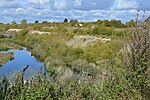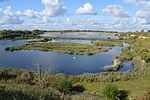Pitstone Windmill
1627 establishments in EnglandGrade II* listed buildings in BuckinghamshireGrinding mills in the United KingdomIvinghoeMill museums in England ... and 7 more
Museums in BuckinghamshireNational Trust properties in BuckinghamshirePitstonePost mills in the United KingdomUse British English from February 2023Windmills completed in 1627Windmills in Buckinghamshire

Pitstone Windmill is a Grade II* listed windmill in England. It is thought to have been built in the early 17th century, and stands in the northeastern corner of a large field near the parish boundary of Ivinghoe and Pitstone in Buckinghamshire. Presently, the windmill belongs to the National Trust.
Excerpt from the Wikipedia article Pitstone Windmill (License: CC BY-SA 3.0, Authors, Images).Pitstone Windmill
B488,
Geographical coordinates (GPS) Address Website External links Nearby Places Show on map
Geographical coordinates (GPS)
| Latitude | Longitude |
|---|---|
| N 51.8317 ° | E -0.6299 ° |
Address
Pitstone Windmill
B488
LU7 9EJ , Ivinghoe
England, United Kingdom
Open on Google Maps








